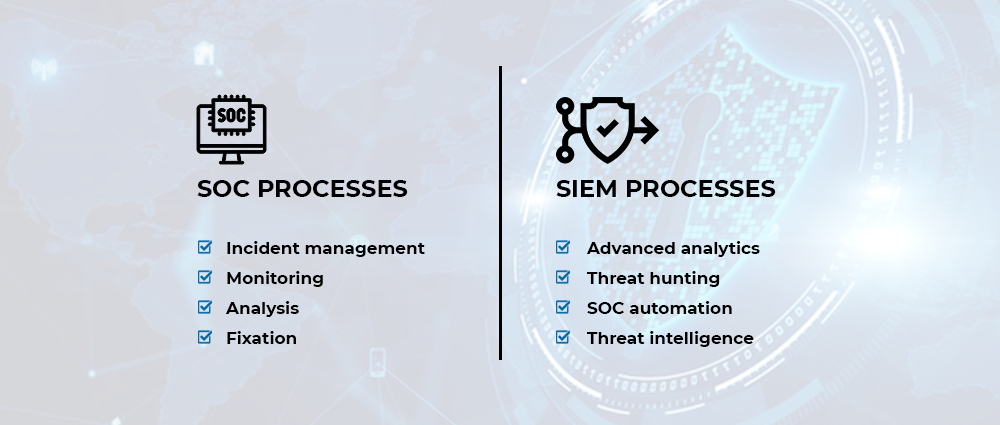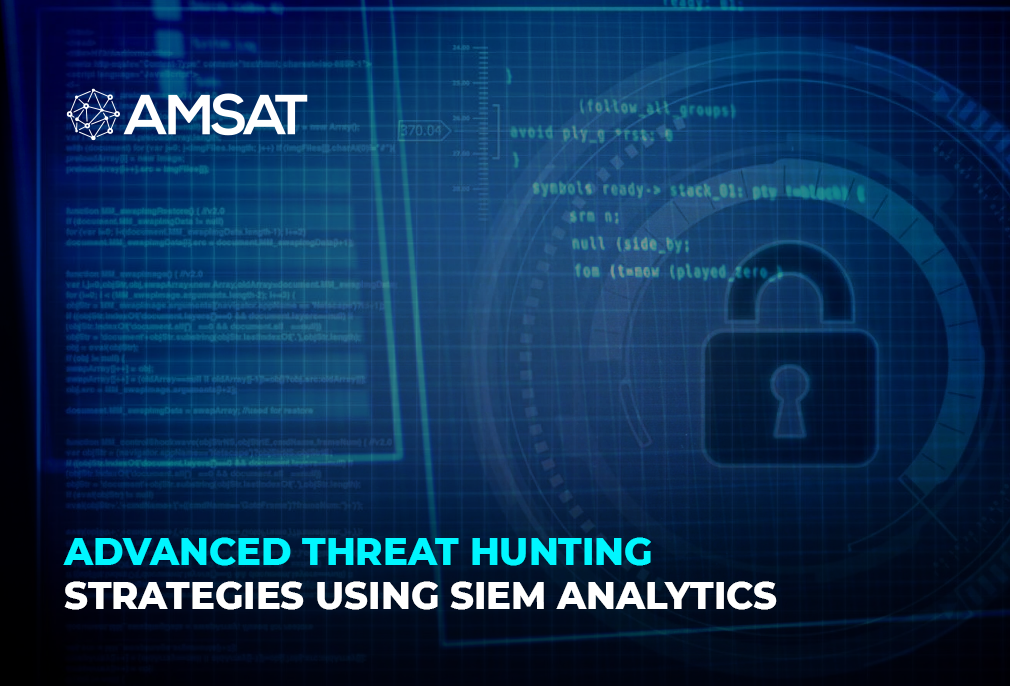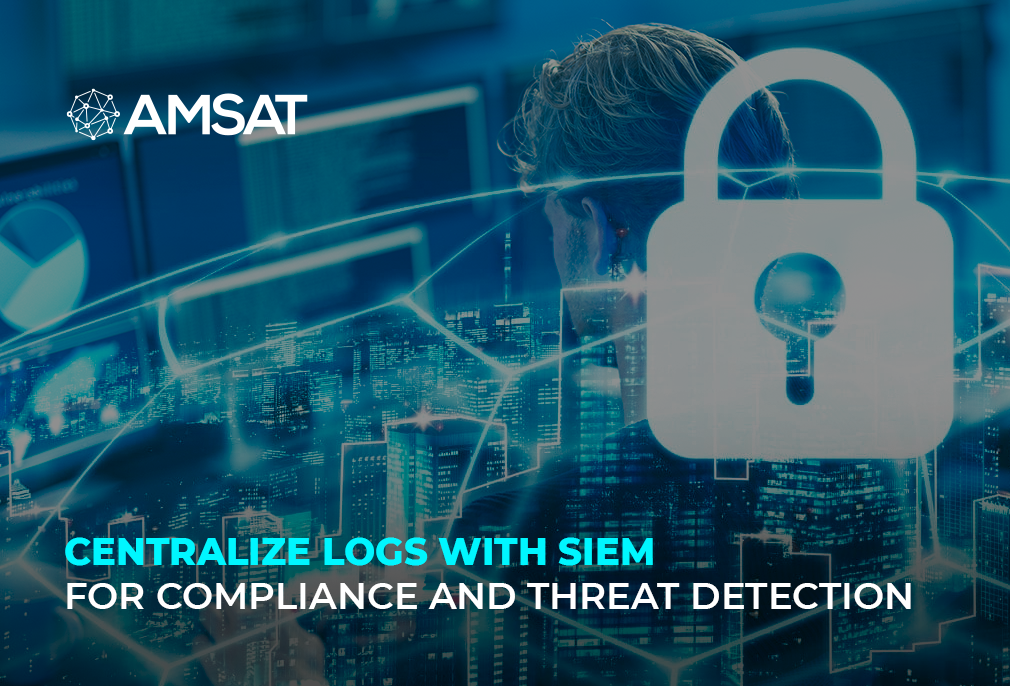Latest Blogs

By AMSAT Apr 01, 2024
SIEM or SOC as a Service: Understanding the Key Differences for Robust Cybersecurity
In today’s ever-escalating threat landscape, robust cybersecurity is inevitable. Organizations face a constant salvo of cyberattacks, making it crucial to have the proper tools and resources to detect, examine, and respond to these threats effectively. Two key components in this fight are SIEM and SOC, which often get confused due to their intertwined nature. While both play vital roles, SIEM and SOC (or SIEM/SOC) differ significantly in their functionality.
SIEM: Security Information and Event Management
Think of a SIEM as a powerful central nervous system for your organization’s security infrastructure. It’s a software solution that collects logs and events from various security tools and devices across your network, including firewalls, intrusion detection systems (IDS), endpoint security tools, and applications. This data is then aggregated, normalized, and analyzed for anomalies and potential security incidents.
Key functions of a SIEM:
- Log collection and aggregation: SIEM gathers data from diverse sources, providing a unified view of security activity.
- Event correlation: SIEM analyzes collected data to identify patterns and potential threats.
- Security incident and event management (SIEM): SIEM helps prioritize security incidents based on severity and automates some response actions.
- Compliance reporting: SIEM facilitates the generation of reports for regulatory compliance purposes.
- Threat intelligence integration: SIEM can integrate with threat intelligence feeds to identify known malicious activities.
Benefits of SIEM services:
- Improved security visibility: SIEM provides a comprehensive view of security events across your entire IT environment.
- Faster threat detection: SIEM helps identify and prioritize potential security incidents more quickly.
- Enhanced incident response: SIEM automates some response actions, allowing security teams to react faster and more efficiently.
- Streamlined compliance reporting: SIEM simplifies the generation of reports needed for compliance with various security regulations.
SOC: Security Operations Center
A SOC, in contrast to SIEM, is the human element of security. It’s a dedicated team of security professionals with the expertise and tools to monitor, analyze, investigate, and respond to security incidents detected by SIEM or other security tools.
Core responsibilities of a SOC team:
- Security monitoring: SOC analysts continuously monitor security events and alerts generated by SIEM and other tools.
- Threat hunting: SOC teams proactively hunt for threats within your network, identifying vulnerabilities and potential attacks.
- Incident response: SOC teams work to contain, eradicate, and recover from security incidents.
- Vulnerability management: SOC teams identify, prioritize, and remediate vulnerabilities in your systems and applications.
- Security policy enforcement: SOC teams ensure adherence to your organization’s security policies and procedures.
Benefits of a SOC:
- Expert analysis: SOC teams possess the knowledge and skills to interpret SIEM data and identify real threats.
- Proactive threat hunting: SOC teams go beyond simply reacting to alerts and actively search for hidden threats.
- Faster incident response: SOC teams can quickly contain and mitigate security incidents, minimizing damage.
- Improved security posture: Effective SOC operations help strengthen your overall security posture.
Limitations of a SOC:
- Costly to build and maintain: Establishing and staffing an in-house SOC can be expensive, especially for smaller organizations.
- Skill shortage: Finding and retaining qualified security analysts can be challenging.
SIEM vs SOC: Choosing the Right Solution
The ideal solution often lies in a combination of SIEM and SOC, referred to as SIEM/SOC. While SIEM provides the technology to collect and analyze data, a SOC team provides the expertise to interpret the data and take action. However, the best option for your organization depends on several factors, including:

- Security budget: If budget is a constraint, SIEM software might be a viable starting point.
- Security expertise: Organizations with in-house security resources can leverage a SIEM with more success.
- Complexity of your IT environment: Larger and more complex environments might necessitate a dedicated SOC team.
Managed SIEM and SOC Services
These services provide access to a team of security professionals who manage and monitor a SIEM solution on your behalf. This allows you to benefit from the expertise of a SOC team without the burden of building and staffing your own. Here’s what managed SIEM and SOC services offer:
- Cost-effectiveness: Managed services are often more cost-effective than building an in-house SOC, especially for smaller organizations.
- Access to expertise: You gain access to a team of experienced security analysts who can monitor your environment 24/7.
- Reduced workload: Managed services free up your internal IT staff to focus on other critical tasks.
- Scalability: Managed services can scale up or down based on your organization’s evolving security needs.
Choosing Between SIEM, SOC, and Managed Services
Here’s a quick breakdown to help you decide which option best suits your needs:
- SIEM: Ideal for organizations with a moderate security budget and some in-house security expertise.
- SOC: Ideal for large organizations with complex IT environments and the resources to build and maintain a dedicated security team.
- Managed SIEM: Ideal for organizations wanting the benefits of a SIEM without the burden of in-house management.
- Managed SOC: Ideal for organizations lacking the resources to build an in-house SOC but requiring a team of experts to monitor and respond to security threats.
Conclusion
Understanding the differences between SIEM and SOC is crucial for building a robust cybersecurity posture. SIEM provides the technology to collect and analyze security data, while a SOC team offers the expertise to interpret the data and take necessary actions. Often, the best approach involves a combination of SIEM and SOC, referred to as SIEM/SOC.
By carefully evaluating your organization’s specific needs and resources, you can select the most effective solution to bolster your cybersecurity defenses and keep your data safe in the ever-evolving threat landscape.
TAGS
- Cyber Threats
- Cyber Security
- SOC
- SIEM
Recent Blogs
Ready to Get Started?
Our specialists are ready to tailor our security service solutions to fit the needs of your organization.










